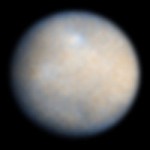
The rugged surface of Vesta as revealed by Dawn passing overhead at a distance of about 1500 km or 1000 miles
The Dawn Spacecraft is slowly spiralling in, closer and closer, to the surface of Vesta. In the image taken above the spacecraft was about 1500 km from the asteroid’s surface (Click the image to rebigulate at the Dawn homepage). A year from now Dawn will be making the closest approaches of the mission, as low as 175 km, increasing resolution by a factor of almost one-hundred.
But Dawn won’t be done then, it has another trick up its sleeve. Thanks to the revolutionary ion rocket engines, the spacecraft will be able to break orbit around Vesta, and head of for a rendezvous with the mysterious dwarf planet Ceres in 2015. For now our best images of Ceres, such as the one right taken by the Hubble Space Telescope, show almost no detail at all even though it is the largest asteroid in the main belt.
The plucky little spacecraft is blazing a trail in more ways than one: Dawn may be the prototype of a new kind of spacecraft that do much more for way less. If such probes were mass-produced rather than built one at a time, the price could be lower still. In 20 years it’s possible we could have a fleet of a dozen or more ion-powered spacecraft ranging through the solar system for decades on end, all for less than the cost of a single decent-sized tax cut for billionaires.


Leave a Reply
You must be logged in to post a comment.